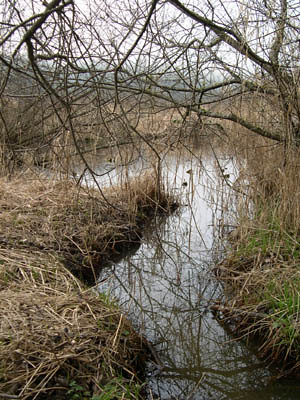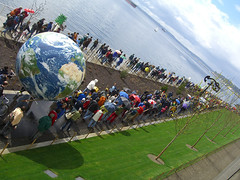What are some of the effects climate change could have on our national parks? Why is it important to understand these impacts and what does it mean for our future enjoyment of these places?

In order to understand the effects of climate change on our parks we must first understand the impacts of climate change on our global environment. Some things, such as warmer average temperatures, are kind of a “no-brainer” but what does all of this mean? How will it impact the flora and fauna, our hydrologic cycle, or our air quality? It is a relatively easy determination to make because it is already happening. Here are some examples of the effects:
Changes in soil temperature & moisture affects soil microflora & microfauna
As temperatures change animals seek different & more optimal habitats
Sensitivity to temperatures affects the reproductive biology of many species as well as how they rear their young
Temperature increases can cause a reduction in the number of species within a community
Population densities & geographic distribution of insects change as ambient temperatures change in their ranges
Sex of many reptile species is often determined by temperature thus the effective population of one sex limits that populations genetic diversity
Global temperature changes can lead to massive reorganizations of the time, activities, and movement patterns of animals
Drought causes leaves of plants & trees to turn yellow as chlorophyll production is reduced, cavitation increases and plants dehydrate making them more attractive to phytophagus insects leaving vegetation susceptible to insect outbreaks
As sea ice cover declines, arctic marine ecosystems will suffer from coastal erosion, melting of tundra/thawing of permafrost, loss of algae, elimination of ice associated communities such as polar cod, and a loss of habitat for ice platform dependent species such as polar bears, seals, and walrus.
Increased wildfire frequency
Increased windstorms sometimes causing the mortality of entire stands of trees and leaving the stressed survivors susceptible to disease and insect infestation
More extreme and unpredictable weather patterns (floods and droughts) cause damage to resources
These examples are merely a drop in the bucket of what we are faced with in regards to the effects of climate change on our environment. While it is understandable that Earth undergoes periods of warming and cooling it is evident that our planet is currently undergoing a very serious and disconcerting period of rapid change. In the last century our planet has warmed an average of 1.3F. This rate of warming is faster than anything on record for the past 1000 years. Emissions of greenhouse gases such as carbon dioxide, nitrous oxide, and methane have been on the rise since the beginning of the industrial revolution.

The concentration of these gasses in the atmosphere is more than 70% higher than pre-industrial levels, and according to the EPA combustion of fossil fuels account for most emissions in the US. Like it or not our environment is changing. Alpine species are running out of higher ground, polar species are running out of ice, droughts, floods, heat waves, and intense hurricanes have increased, glaciers and snow packs are disappearing, sea level is rising, arctic sea ice is thinning, and our oceans are becoming more acidic. Bearing this in mind, it is not hard to imagine how climate change will, and already is, affecting our national parks.

It is no secret that Rocky Mountain National Park is currently undergoing a battle with bark beetle infestations that are killing millions of trees. It is believed among entomologists that these massive infestations are a result of climate change. Remember those phytophagus insects? These insects are specialized to detect ultrasound and vibrations from cavitation (the breaking of water columns in trees) caused by drought and reduced chlorophyll production.

In November 2006 over 18 inches of rain fell in just 36 hours in Mount Rainier National Park. This was the most damaging flood in the park’s 108 year history, breaking utility lines, washing out roads, trails and campgrounds, and filling streams and reservoirs with mud and debris. Some major roads through the park were closed for a year. It is estimated that rebuilding will cost between $36 and $100 million.

Glacier National Park may soon be called “Puddles” as many of the glaciers retreat from view and often disappear altogether. Dan Fagre, a USGS ecologist who works at Glacier, estimates that by the year 2020 there very well may be no more glaciers in the park. This means more than just less ice in the park. It also means the destruction of fragile ecosystems that have taken thousands of years to develop destroying the treasures the park was created to protect.

A hot dry climate weakens trees and vegetation making them more susceptible to fires. Record heat waves make for extremely dry vegetation and can even turn good intentions into disasters. A prescribed burn for brush control in Yosemite National Park recently jumped fire lines and as of yesterday evening (August 27, 2009) has burned an estimated 2200 acres and is only 10% contained.

The North Cascades National park is one of the largest and most rugged alpine wilderness in the Lower 48 and its 300 glaciers cover more area land than any glaciers than in any other national park south of Alaska. It is home to grizzly bears and wolves as well as virgin Western Red Cedar (Thuja plicata) and Douglas fir (pseudotsuga menziesii). As the climate warms glaciers retreat and alpine meadows disappear leaving high-mountain species like the pika no where higher to go.

Alaska‘s national parks provide valuable habitat for caribou, which is still central to the diet and culture of many Alaskan Natives. A warmer climate has pushed the caribou as far north as they can go as the tundra ecosystem is being pushed steadily north. In some places in Alaska warmer winters increase the frequency of freeze-thaw cycles which creates thick layers of ice that caribou must break through in order to forage. In other places the snowfall is so heavy that caribou have a hard time finding food under deep snowpack.
Biscayne National Park in Florida, a popular marine vacation destination, generates millions of dollars every year for local economies. The coral reef that attracts so many visitors is now fading, its brilliant colors turning white as they lose the tiny algae living inside the cells that give them their color. This bleaching also causes long term changes in the communities of fish that live on the reef. Diseases that thrive in warmer water have increased dramatically since 1994.

The Great Smoky Mountains National Park is the most visited park in the country. Every year more than 20 million people drive along the Blue Ridge Parkway which connects the park with Shenandoah. Increased traffic and the resulting smog decrease the air quality in the park, compounding an already existing problem.
Sequoia, Kings Canyon, Joshua Tree, and Yosemite National Parks all have higher ozone levels than allowed by EPA health standards as warmer temperatures boost the formation of ground level ozone.
Documenting, understanding, analyzing, and interpreting the changes currently taking place in both our global environment and within our national parks can provide crucial information on how we can deal with what is coming our way, what we might expect to happen, and how we can prevent or minimize the effects of climate change. This is the exact reason why it is necessary to establish and fund scientific research within the parks. We need to accumulate the knowledge necessary to formulate a comprehensive, adaptable and systemic plan to minimize or eliminate the threats to these valuable resources.
The species within the parks will not be the only ones suffering the consequences of climate change. Visitors and neighboring communities will also feel the effects. Poor air quality will decrease the number of days that people with respiratory problems such as asthma can safely enjoy the parks. Poor visibility due to smog will degrade the quality of those grand vistas in places like Joshua Tree, Great Smoky Mountains, Yosemite and the Grand Canyon. Increased natural disasters not only damage park structures but take a toll on gateway towns such as the hard hit Flamingo area just outside of the Everglades National Park. Just getting into many parks could prove to be difficult as flooding and erosion wipe out roadways into the parks and inconvenience visitors and spell trouble for neighboring communities dependent on park visitor traffic.
National parks are doing their part to reduce their greenhouse gas emissions by taking advantage of solar and wind power, providing shuttle services to visitors helping to eliminate emissions from visitor traffic, converting to fuel efficient vehicles and promoting bicycle use in parks. So far there are almost 50 national parks participating in the Climate Friendly Parks program. This partnership between the EPA, NPCA, and NPS aims to educate every park employee about climate change so they can take action in addressing the problem. The program also calls for each park to reduce its emissions of greenhouse gases and air pollution as well as educating the public about the effects of climate change on park resources while encouraging them to reduce their own greenhouse gas emissions.
It is clear that global warming is a global problem. We all must become more aware of our contributions to this problem and take steps as individuals to reduce the effects of climate change on our world and in our national parks. We must begin now before the things we love disappear forever.
































